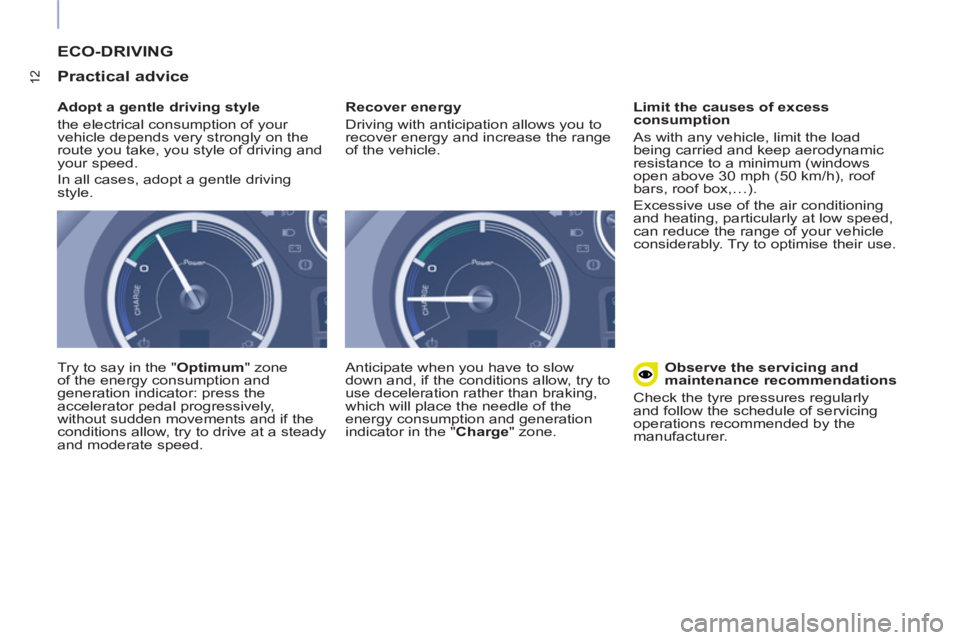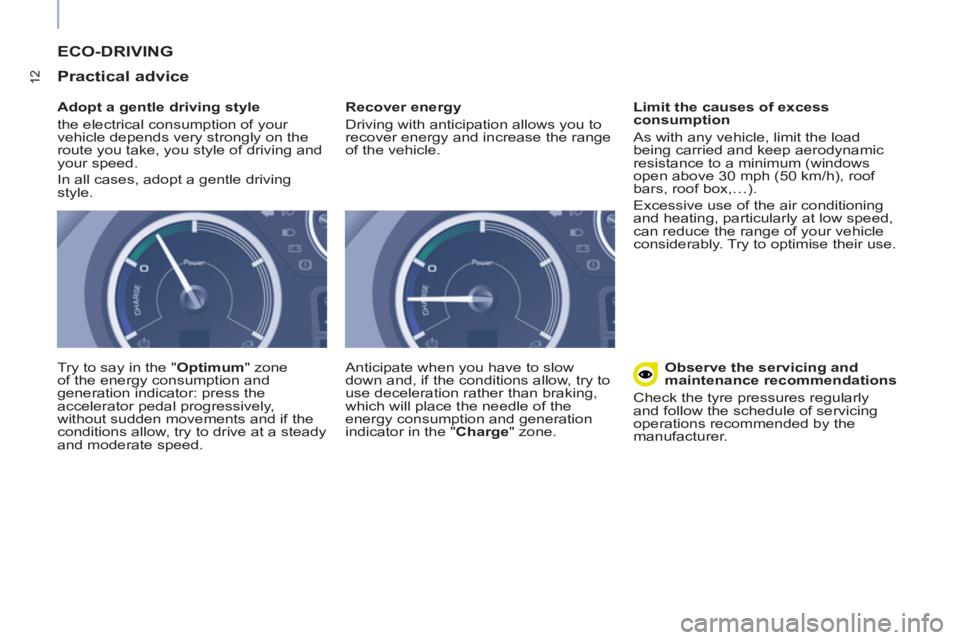Page 270 of 328

12
ECO-DRIVING
Practical advice
Adopt a gentle driving style
the electrical consumption of your
vehicle depends very strongly on the
route you take, you style of driving and
your speed.
In all cases, adopt a gentle driving
style.
Try to say in the " Optimum
" zone
of the energy consumption and
generation indicator: press the
accelerator pedal progressively,
without sudden movements and if the
conditions allow, try to drive at a steady
and moderate speed.
Recover energy
Driving with anticipation allows you to
recover energy and increase the range
of the vehicle.
Anticipate when you have to slow
down and, if the conditions allow, try to
use deceleration rather than braking,
which will place the needle of the
energy consumption and generation
indicator in the " Charge
" zone.
Limit the causes of excess
consumption
As with any vehicle, limit the load
being carried and keep aerodynamic
resistance to a minimum (windows
open above 30 mph (50 km/h), roof
bars, roof box,…).
Excessive use of the air conditioning
and heating, particularly at low speed,
can reduce the range of your vehicle
considerably. Try to optimise their use.
Observe the servicing and
maintenance recommendations
Check the tyre pressures regularly
and follow the schedule of servicing
operations recommended by the
manufacturer.
Page 271 of 328
13
ECO-COMFORT
ECO-COMFORT
Control the use of electrical
equipment
The heating and air conditioning
operate using energy supplied by
the traction battery. Excessive use
signifi cantly reduces the range of your
vehicle. Try to optimise their use as
soon as you reached the desired level
of comfort and check the settings at
every start in order to maximise range.
Also limit the use of demisting and
defrosting and of the heated seat.
Stop the heating or air
conditioning and maintain
ventilation.
Stop the heating or air
conditioning and ventilation.
Pressing the ECO
button stops
the heating and air conditioning
(but maintains ventilation). The
needle of the energy consumption and
generation indicator is placed in the
ECO
zone.
Operating the temperature
control activates the heating
or air conditioning and
stops ECO
mode.
Page 272 of 328

14
MANUAL AIR CONDITIONING AND HEATING
ECO
(stops the air conditioning
and heating).
OFF
(stops the heating, air
conditioning and ventilation).
Windscreen demist.
Rear screen demist on
versions with glazed rear
doors.
Air distribution.
Recirculation of interior air/
Intake of exterior air.
Increase/Reduce air fl ow.
Increase/Reduce temperature.
Ventilation can be used as
soon as this indicator is on.
After a prolonged period without
use of the heating system, its
operation may result in a slight
odour during the fi rst few minutes
of use.
Special features of the air
conditioning and heating
The air conditioning and heating
systems do not regulate the
temperature in the cabin directly, but
ensure a constant temperature at the
fan-fed air vents (a temperature which
is indexed to the level of hot or cold
desired by the users).
if you want to rapidly heat or cool the
vehicle cabin, you can temporarily set
the temperature control to maximum
hot or cold.
It should be noted however that:
- The air conditioning system
(cooling of the air) only operates
when the ambient temperature is
above 15°C,
- The power of the heating system
is progressively restricted when
the ambient temperature is above
20°C.
Manual heating version
Practical advice
Heating and ventilation
In winter, air distribution
towards the footwells is
recommended, allowing a
more uniform ambience to be
obtained in the cabin.
In summer, distribution towards the
face-level vents will increase the
effectiveness of the ventilation and air
conditioning.
In heating mode, try to use
moderate level of ventilation,
that is less than 3 blades. This
will allow the system to deliver
air at a higher temperature.
Air distribution
Page 304 of 328
10
DISPLAY SCREENS
Screen (depending on
equipment level)
Each press of the button on the end
of the windscreen wiper stalk displays
successively the different trip computer
information, depending on the type of
screen.
Setting the units
Range
It displays:
- the estimated range remaining,
- the additional range available
by using the ECO
mode on the
heating and air conditioning control
panel,
- the additional range after stopping
the heating and air conditioning.
They display:
- a trip distance recorder (choice of
trip 1 or 2),
- the average energy consumption from
the battery (over 62 miles (100 km)),
- the speed.
Trips (1 and 2)
This screen displays an estimate of the
number of miles or kilometres driving
range before the battery has to be
charged.
Instrument panel
Page 306 of 328

12
ECO-DRIVING
Practical advice
Adopt a gentle driving style
the electrical consumption of your
vehicle depends very strongly on the
route you take, you style of driving and
your speed.
In all cases, adopt a gentle driving
style.
Try to say in the " Optimum
" zone
of the energy consumption and
generation indicator: press the
accelerator pedal progressively,
without sudden movements and if the
conditions allow, try to drive at a steady
and moderate speed.
Recover energy
Driving with anticipation allows you to
recover energy and increase the range
of the vehicle.
Anticipate when you have to slow
down and, if the conditions allow, try to
use deceleration rather than braking,
which will place the needle of the
energy consumption and generation
indicator in the " Charge
" zone.
Limit the causes of excess
consumption
As with any vehicle, limit the load
being carried and keep aerodynamic
resistance to a minimum (windows
open above 30 mph (50 km/h), roof
bars, roof box,…).
Excessive use of the air conditioning
and heating, particularly at low speed,
can reduce the range of your vehicle
considerably. Try to optimise their use.
Observe the servicing and
maintenance recommendations
Check the tyre pressures regularly
and follow the schedule of servicing
operations recommended by the
manufacturer.
Page 307 of 328
13
ECO-COMFORT
ECO-COMFORT
Control the use of electrical
equipment
The heating and air conditioning
operate using energy supplied by
the traction battery. Excessive use
signifi cantly reduces the range of your
vehicle. Try to optimise their use as
soon as you reached the desired level
of comfort and check the settings at
every start in order to maximise range.
Also limit the use of demisting and
defrosting and of the heated seat.
Stop the heating or air
conditioning and maintain
ventilation.
Stop the heating or air
conditioning and ventilation.
Pressing the ECO
button stops
the heating and air conditioning
(but maintains ventilation). The
needle of the energy consumption and
generation indicator is placed in the
ECO
zone.
Operating the temperature
control activates the heating
or air conditioning and
stops ECO
mode.
Page 308 of 328

14
MANUAL AIR CONDITIONING AND HEATING
ECO
(stops the air conditioning
and heating).
OFF
(stops the heating, air
conditioning and ventilation).
Windscreen demist.
Rear screen demist on
versions with glazed rear
doors.
Air distribution.
Recirculation of interior air/
Intake of exterior air.
Increase/Reduce air fl ow.
Increase/Reduce temperature.
Ventilation can be used as
soon as this indicator is on.
After a prolonged period without
use of the heating system, its
operation may result in a slight
odour during the fi rst few minutes
of use.
Special features of the air
conditioning and heating
The air conditioning and heating
systems do not regulate the
temperature in the cabin directly, but
ensure a constant temperature at the
fan-fed air vents (a temperature which
is indexed to the level of hot or cold
desired by the users).
if you want to rapidly heat or cool the
vehicle cabin, you can temporarily set
the temperature control to maximum
hot or cold.
It should be noted however that:
- The air conditioning system
(cooling of the air) only operates
when the ambient temperature is
above 15°C,
- The power of the heating system
is progressively restricted when
the ambient temperature is above
20°C.
Manual heating version
Practical advice
Heating and ventilation
In winter, air distribution
towards the footwells is
recommended, allowing a
more uniform ambience to be
obtained in the cabin.
In summer, distribution towards the
face-level vents will increase the
effectiveness of the ventilation and air
conditioning.
In heating mode, try to use
moderate level of ventilation,
that is less than 3 blades. This
will allow the system to deliver
air at a higher temperature.
Air distribution